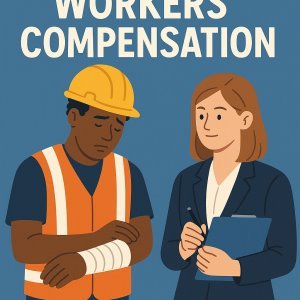How to Buy Workers’ Comp Insurance for Your Georgia Security Guard Company
August 12, 2025As the renewal date for workers’ compensation insurance approaches, nursing home administrators and risk managers face the critical task of ensuring comprehensive preparedness. With just 30 days remaining, the window to review, update, and optimize your workers’ comp coverage is narrowing rapidly. A methodical and timely approach not only safeguards your facility against potential lapses but also positions you to manage costs effectively and maintain compliance with regulatory requirements. This article presents a detailed 30-day countdown checklist designed to guide nursing homes through the essential steps of their workers’ comp renewal process, helping to mitigate risk and foster a safer workplace for all staff.
Table of Contents
- Preparing Comprehensive Documentation for Seamless workers’ Compensation Renewal
- evaluating Risk management Practices to Enhance Safety Protocols
- Updating Employee Training and Compliance Measures for Regulatory Adherence
- Collaborating with Insurance Providers to optimize Coverage and Cost Efficiency
- Q&A
- To Conclude
Preparing Comprehensive Documentation for Seamless Workers’ Compensation Renewal
Ensuring a smooth renewal process for workers’ compensation in nursing homes begins with assembling detailed, accurate documentation. This includes updated employee rosters,payroll records,and incident logs from the past policy period. Focus especially on any claims made during the year,providing thorough summaries with dates,outcomes,and corrective actions implemented. Documentation should also highlight any training programs conducted to reduce workplace injuries, demonstrating proactive risk management to your carrier. Keeping these records well-organized accelerates underwriting review and reduces the chance of unexpected premium increases or coverage lapses.
In preparation, consider using a structured checklist to gather the necessary documents systematically. Below is an example of critical items to have on hand:
| Documentation Type | Purpose | Notes |
|---|---|---|
| Employee Roster | Verify coverage eligibility | Ensure role classifications are accurate |
| Payroll Records | Calculate premium basis | Include any overtime or bonuses |
| Claims History | Demonstrate risk profile | Summarize all incident resolutions |
| Safety Training Logs | Support risk mitigation efforts | Include dates and attendance |
By proactively compiling comprehensive documentation, nursing homes position themselves for a streamlined renewal process that minimizes delays and positions their risk profile favorably with insurers.
Evaluating Risk Management practices to Enhance Safety Protocols
Effective risk management begins with a thorough evaluation of existing safety protocols. To elevate protection measures, it’s essential to conduct regular audits that identify vulnerabilities before they translate into incidents.Nursing homes should focus on encompassing all possible hazards, from patient mobility challenges to potential exposure to infectious diseases. Engaging frontline staff in this evaluation not only provides practical insights but also fosters a culture of safety and accountability. Key elements to assess include staff training adequacy, emergency response readiness, and the maintenance of equipment standards.
Prioritizing continuous enhancement is critical for sustaining a safe environment. Implementing corrective actions swiftly after each risk assessment minimizes liability and enhances workers’ comp outcomes. Nursing homes can leverage data-driven approaches by analyzing injury patterns and near-misses to tailor safety initiatives effectively.
- Review incident and accident reports monthly
- Update protocols based on recent legislative changes
- Invest in ergonomic equipment to reduce strain injuries
- Conduct mandatory refresher safety training quarterly
| Risk Factor | Current Protocol | Action Required | Deadline |
|---|---|---|---|
| Slip and Fall Hazards | Monthly floor inspections | Increase to weekly | Within 7 days |
| Manual Patient Handling | Annual training | Add bi-annual refreshers | 30 days |
| Infection Control | Standard sanitization | COVID-19 protocol update | Immediate |
Updating Employee Training and Compliance measures for Regulatory Adherence
Ensuring that all employees are current with mandatory training programs is crucial to maintaining OSHA compliance and minimizing workplace injuries. Begin by conducting a thorough audit of existing training records to identify lapses or upcoming expirations. Focus not only on initial certifications but also on refresher courses critical to high-risk areas such as patient handling, infection control, and emergency response protocols. Utilize digital tracking systems to streamline compliance monitoring and automatically prompt staff when renewals are due, reducing administrative burden and preventing oversight.
Compliance efforts are bolstered by establishing clear interaction channels to update employees about changes in regulatory requirements. Incorporate brief,targeted training sessions complemented by job-specific compliance checklists that employees can refer to on the floor. Below is a sample checklist highlighting key training modules to prioritize during the renewal period:
| training Module | Frequency | Last Completed | Status |
|---|---|---|---|
| Workplace Safety & Injury prevention | Annual | 07/15/2023 | Due for Renewal |
| Patient Handling techniques | Biannual | 01/10/2024 | Up to Date |
| Infection Control Protocols | Quarterly | 03/05/2024 | Pending |
| Emergency Evacuation Procedures | Annual | 08/20/2023 | Due for Renewal |
- Leverage peer mentors: Assign experienced staff to guide new hires on compliance best practices.
- Regular feedback loops: Implement mechanisms for employees to report training gaps or safety concerns in real time.
- Documentation rigor: Keep meticulous records of completed trainings and certifications for audit readiness.
Collaborating with Insurance Providers to Optimize Coverage and Cost Efficiency
Establishing a obvious and proactive relationship with your insurance providers is crucial in enhancing workers’ compensation coverage while managing premium costs effectively. Schedule regular consultations well before your renewal date to review your policy’s current performance, claims history, and any changes in your nursing home’s risk profile.Collaborate closely on risk management initiatives, such as safety training programs or ergonomic assessments, which can be instrumental in reducing workplace injuries and subsequently lowering insurance costs. Don’t hesitate to request detailed reports from your insurer, breaking down the premium calculations to identify potential areas for adjustment or negotiation.
Maximizing cost efficiency frequently enough involves exploring alternative coverage options and riders that align specifically with the unique risks in the nursing home sector. Consider leveraging the following strategies during discussions with your insurer:
- Experience Modification Rate (EMR) Analysis: Ensure your facility’s EMR accurately reflects your safety record, as even a slight adjustment can significantly impact premiums.
- Claim review & Resolution: Work together to promptly address outstanding claims that may artificially inflate your costs.
- Customized Policy Endorsements: Include or remove endorsements to fine-tune coverage and reduce needless expenses.
| Negotiation Focus | Potential Benefits |
|---|---|
| Safety Incentives | Premium discounts for demonstrated safety improvements |
| claims Handling Procedures | Faster claim resolution, reduced administrative fees |
| Policy Adjustments | Tailored coverage limits to avoid overpayment |
Q&A
Q&A: Workers’ comp Renewal Checklist for Nursing Homes – 30-Day Countdown
Q1: Why is it crucial for nursing homes to start the workers’ comp renewal process 30 days before the policy expiration?
A1: Beginning the renewal process 30 days in advance allows nursing homes sufficient time to gather necessary data, review claims history, update payroll data, and negotiate terms with insurers. This proactive approach helps avoid coverage gaps, ensures compliance, and may result in more favorable premiums.
Q2: What key documents should nursing homes prepare for their workers’ comp renewal?
A2: Essential documents include the previous policy declarations, updated payroll records broken down by job classification, claims history with detailed loss runs, any safety program updates, and state-specific compliance certifications. Having these organized facilitates a smooth renewal process.
Q3: How does reviewing the claims history impact workers’ comp renewal for nursing homes?
A3: Analyzing claims history helps identify patterns of workplace injuries or recurring risks. Nursing homes can use this information to implement targeted safety measures, which insurers view positively and may reflect in reduced premiums or improved coverage terms.
Q4: What role do updated employee classifications play in the renewal process?
A4: Accurate employee classification ensures that payroll is assigned properly according to job roles and associated risk levels. Misclassification can lead to incorrect premium calculations, potential audits, and penalties. Nursing homes must review and update classifications to match current staffing and duties.
Q5: Can implementing workplace safety programs affect workers’ comp renewal rates?
A5: Yes. Demonstrating active and effective safety programs can lower the perceived risk to insurers.Nursing homes that invest in employee training, injury prevention protocols, and ergonomic assessments often benefit from improved renewal terms and discounts.
Q6: What steps should nursing homes take if they anticipate critically important changes in operations or staffing before renewal?
A6: Nursing homes should proactively inform their insurance provider about any changes such as expansions,reductions in workforce,or modifications in services. Accurate information aids in adjusting coverage limits and premiums to reflect the current risk profile.
Q7: how can nursing homes leverage the 30-day window to explore alternative insurance providers?
A7: The 30-day timeframe provides an opportunity to obtain and compare quotes from multiple carriers. This competitive approach can uncover better coverage options or pricing, helping nursing homes secure the best value for their workers’ comp insurance.
Q8: What are common pitfalls nursing homes should avoid during workers’ comp renewal?
A8: Common pitfalls include delaying the renewal process until the last minute, failing to update payroll and employee data, ignoring claims history reviews, and neglecting to communicate operational changes. These can lead to higher premiums, coverage lapses, or denial of claims.
Q9: who in a nursing home organization should be responsible for managing the workers’ comp renewal process?
A9: Typically, the risk manager, human resources director, or facility administrator oversees the renewal process. Collaboration among these roles ensures all relevant data is accurate and comprehensive, supporting effective negotiations with insurers.
Q10: How does maintaining workers’ comp insurance benefit nursing homes beyond compliance?
A10: Beyond regulatory compliance, maintaining adequate workers’ comp coverage protects nursing homes from costly litigation, supports injured employees’ recovery, and promotes a safer workplace culture. This ultimately contributes to operational stability and reputation management.
To Conclude
a well-organized workers’ compensation renewal process is essential for nursing homes to maintain compliance, control costs, and ensure the safety and well-being of their staff. By adhering to this 30-day countdown checklist, administrators can systematically review policies, update employee information, assess risk management strategies, and collaborate effectively with insurers. Proactive planning not only streamlines the renewal process but also fosters a workplace culture committed to minimizing workplace injuries and supporting employee health. Prioritizing these steps today will position your nursing home for a smoother renewal experience and a stronger foundation for the year ahead.
“This content was generated with the assistance of artificial intelligence. While we strive for accuracy, AI-generated content may not always reflect the most current information or professional advice. Users are encouraged to independently verify critical information and, where appropriate, consult with qualified professionals, lawyers, state statutes and regulations & NCCI rules & manuals before making decisions based on this content.







